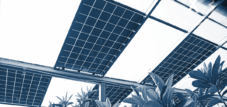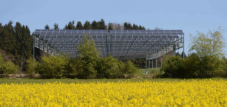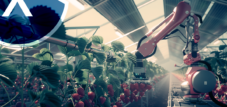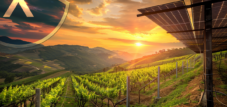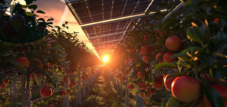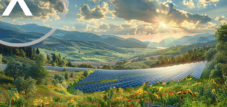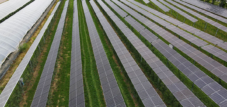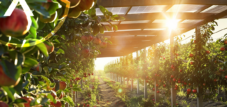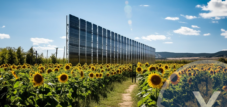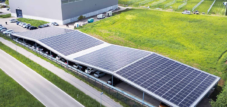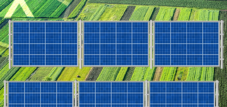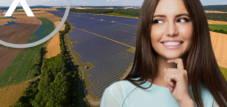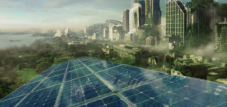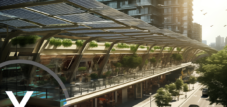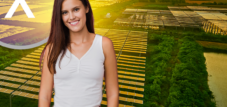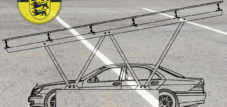Water and watts make wine: berry cultivation with photovoltaics and a closed water cycle - transparent PV modules solar solutions from BaWü
Language selection 📢
Published on: June 23, 2024 / update from: June 23, 2024 - Author: Konrad Wolfenstein
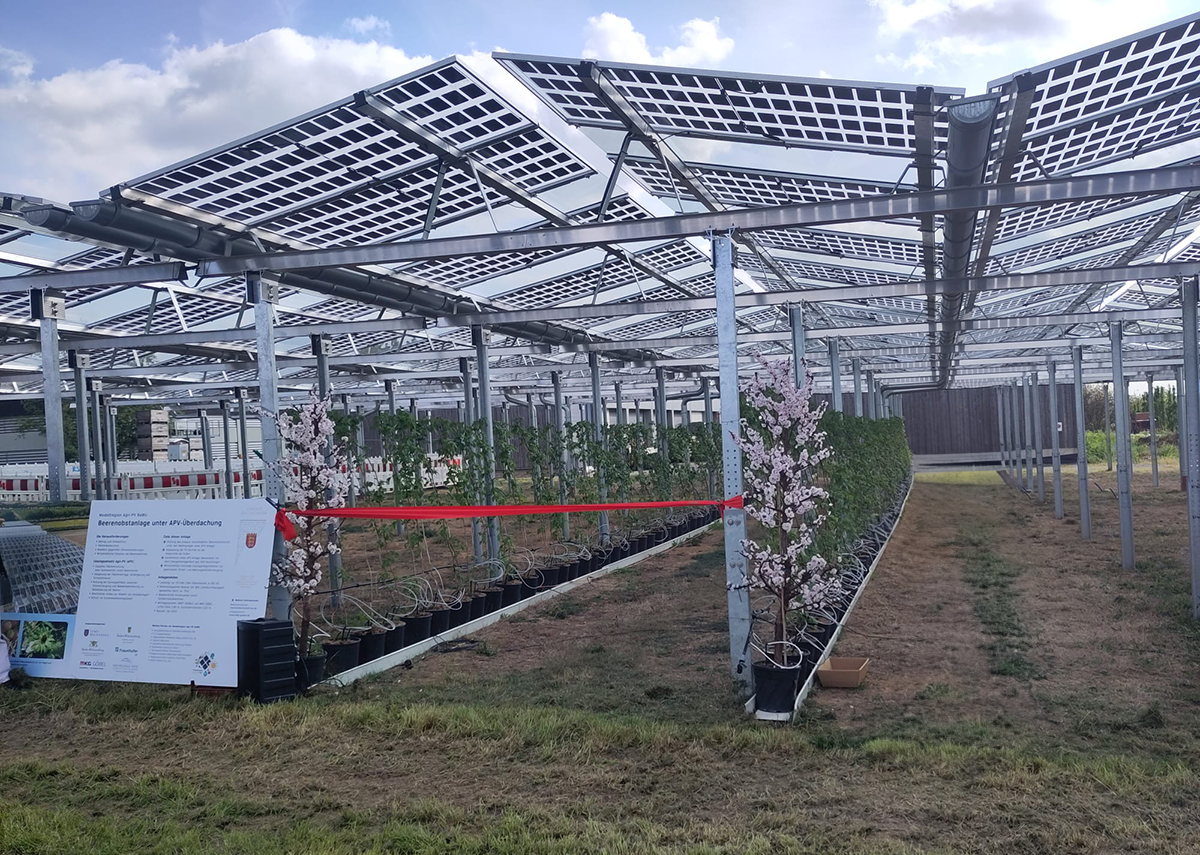
The Agri-PV system for various types of berries has completely closed circuits for water and nutrients - Image: Fraunhofer ISE | Oliver Hörnle
🌞🍇 Agri-photovoltaics: An innovative solution for sustainable viticulture
🌿⚡ Agricultural use in combination with photovoltaics, also known as Agri-PV, has become significantly more important in recent years. This method makes it possible to have dual use of agricultural land by using it for food production and at the same time for generating solar energy. Especially in wine growing, these technologies seem to offer a promising way to meet the challenges of climate change and secure crop yields in the long term. The focus is particularly on Baden-Württemberg, where various pilot projects test and optimize the use of Agri-PV in viticulture.
The idea of agri-photovoltaics is not new. Professor Adolf Goetzberger, the founder of the renowned Fraunhofer Institute for Solar Energy Systems (ISE), developed the concept back in 1981. His vision was to install solar panels over agricultural crops to simultaneously generate solar power and protect the crops. Fraunhofer ISE today estimates that Germany's entire current electricity needs could be covered by using four percent of agricultural land using Agri-PV alone. However, it is important that the PV installations do not take up more than 15 percent of the agricultural area so as not to impair agricultural use.
A prime example of the successful implementation of Agri-PV can be found in Baden-Württemberg as part of the research project “Model Region Agri-Photovoltaics for Baden-Württemberg”. Here, the Weinsberg State Teaching and Research Institute for Viticulture and Fruit Growing (LVWO), Fraunhofer ISE and eleven other project partners are working on five Agri-PV pilot systems. These systems are used to investigate the interactions between electricity generation and agricultural yield in viticulture. Last year, Minister for Food, Rural Areas and Consumer Protection of Baden-Württemberg, Peter Hauk, opened a research center in Heuchlingen that tests a particularly innovative agri-PV system on various types of berries. This system is characterized by the fact that it uses completely closed cycles for water and nutrients to make the cultivation of bushberries and strawberries as resource-efficient as possible.
📊 The advantages of Agri-PV 🌿
PV roofing offers a variety of benefits, especially for weather-sensitive permanent crops such as grape vines and various fruits. It protects the plants from extreme weather conditions, be it too much sunlight, heavy rain or hail. Studies by Fraunhofer ISE have shown that the use of Agri-PV can significantly reduce the irrigation requirements of plants. In addition, the partial shading of the plants improves the microclimate, which has a positive effect on plant growth.
A key advantage of Agri-PV is the reduction in irrigation requirements. This property is invaluable, especially in times of climate change, when water is increasingly becoming a scarce resource. The partial shades provided by the solar panels help keep the ground cooler and moister. This not only leads to more efficient water use, but also a reduction in water loss through evaporation.
The Agri-PV system also helps protect against extreme weather events. For example, heavy rains, which are increasingly occurring due to climate change, can severely impact crops. The solar panels act as an additional protective shield and reduce the direct impact of heavy rain and hail on the plants. This is particularly valuable for delicate crops such as grape vines, which can be easily damaged by such weather events.
🌍 Successful models from other countries 📈
Although Agri-PV is still in its infancy in Germany, there are international role models that demonstrate the benefits and efficiency of this method. Agri-PV is already being used successfully in countries such as China, India and France. For example, France has several large-scale agri-PV projects where solar panels have been installed over grape vines to maximize both energy output and crop yields. These projects have shown that Agri-PV not only helps generate renewable energy but also improves agricultural production conditions.
⚙️ Technological challenges and solutions 🔧
Despite the numerous advantages, there are also challenges that must be overcome when implementing Agri-PV. A key challenge is finding the right balance between light transmission and shadows. The solar panels must be designed in such a way that they allow enough sunlight for the plants growing beneath them, while at the same time generating enough energy. This is where transparent PV modules come into play, which were specifically developed for use in agriculture. These modules allow the necessary light for plant growth to pass through while still generating electricity.
Another challenge is the integration of the PV modules into the existing agricultural infrastructure. The installations must be designed in such a way that they do not hinder the cultivation of the fields. This requires innovative solutions in the design and placement of the PV systems.
🔭 The perspective for Germany 🌐
Germany has the potential to benefit enormously from Agri-PV. Particularly in regions that are severely affected by climate change, such as wine-growing regions in Baden-Württemberg and Hesse, the integration of PV systems could help secure agricultural yields. The ongoing pilot projects provide valuable insights and data that can help further refine the technology and increase its efficiency.
Future developments could also include combining agri-PV with other sustainable technologies, such as wind power or the use of biogas plants. Such integrated systems could further increase energy efficiency and contribute to even more sustainable agriculture.
🌧️🌱 Protecting plants from extreme weather conditions and reducing the need for irrigation
Agri-photovoltaics represents a promising method for using agricultural land more efficiently and at the same time contributing to the energy transition. By protecting crops from extreme weather conditions and reducing irrigation needs, Agri-PV offers a sustainable solution to many of the current challenges in agriculture. While Germany is still in the development and testing phase, international examples already show the enormous potential of this innovation. With the right funding and further research, agri-PV systems could become an integral part of German agriculture in the near future and thus contribute to both securing food production and achieving climate goals.
📣 Similar topics
- 🌱 Agri-photovoltaics: A new era of sustainable viticulture
- 🌞 Dual use: Agriculture meets solar energy
- 🍇 Agri-PV in Baden-Württemberg: Pilot projects and innovations
- 🌍 The idea behind Agri-PV: From Professor Goetzberger to today
- 🌧️ Protection and saving: How Agri-PV counteracts weather extremes
- 🔬 Agri-PV technologies: light transmission and performance
- 🌿 Success models worldwide: China, India and France set standards
- ⚡ Energy and harvest: Agri-PV in German wine-growing regions
- 🚜 Integration and challenges: Agri-PV in practice
- 🌍🌱🌞 Sustainable future: Agri-PV and other green technologies
#️⃣ Hashtags: #AgriPV #Sustainability #RenewableEnergy #Viticulture #Climate Protection
📌 Other suitable topics
🎯🎯🎯 Benefit from Xpert.Digital's extensive, fivefold expertise in a comprehensive service package | R&D, XR, PR & SEM

AI & XR 3D Rendering Machine: Fivefold expertise from Xpert.Digital in a comprehensive service package, R&D XR, PR & SEM - Image: Xpert.Digital
Xpert.Digital has in-depth knowledge of various industries. This allows us to develop tailor-made strategies that are tailored precisely to the requirements and challenges of your specific market segment. By continually analyzing market trends and following industry developments, we can act with foresight and offer innovative solutions. Through the combination of experience and knowledge, we generate added value and give our customers a decisive competitive advantage.
More about it here:
🌿📚 Research project and inauguration of the first pilot plant
🌿💡 As part of the innovative research project “Model Region Agri-Photovoltaics for Baden-Württemberg”, the Weinsberg State Teaching and Research Institute for Viticulture and Fruit Growing (LVWO), the Fraunhofer Institute for Solar Energy Systems ISE and eleven other project partners are working on five exemplary ones To develop and test agri-PV pilot systems in the state of Baden-Württemberg. In May 2022, the first of these pilot systems at the Heuchlingen site, a station of the LVWO, was ceremoniously inaugurated by Baden-Württemberg's Minister for Food, Rural Areas and Consumer Protection, Peter Hauk. This research facility is characterized by a special and sustainable concept: It combines the cultivation of a wide variety of berries with a closed circulation system for water and nutrients to enable environmentally friendly and resource-efficient production.
🌿🔬 Project management and goal setting
The research project “Model Region Agri-Photovoltaics for Baden-Württemberg”, which runs up to and including 2024, is largely led by Fraunhofer ISE and supported by the state ministries for the environment, climate and energy industry as well as for food, rural areas and consumer protection. The aim of the project is to establish the concept of agri-photovoltaics as a space-efficient and sustainable form of land use in the region and, in particular, to promote the potential in the area of special crops, such as fruit and berry cultivation.
🌿🏞️ Technical details of the pilot plant
The pilot plant in Heuchlingen has an installed capacity of 113 kilowatts peak and covers an area of around 2,000 square meters. Various types of berries, including raspberries, blueberries, currants, strawberries, gooseberries and blackberries, are cultivated and researched in substrate cultivation on this area. The research team is investigating the influence of the agri-photovoltaic system on the cultivation of these berry species and is testing the use of different substrates, with a particular focus on peat-free and peat-reduced alternatives.
🌿💧 Water management and sustainability
A central feature of the Agri-PV system in Heuchlingen is the closed water circulation system. In this system, rainwater is collected and stored in a storage tank so that it can then be used - in combination with fresh water - to irrigate the plants. The excess liquid that flows from the substrate of the berry plants is collected, processed and reused by a solar-powered system. This process enables a significant reduction in fertilizer use and at the same time prevents nutrients from leaching into the groundwater.
🌿🌍 Analysis and long-term goals
The agricultural and environmentally friendly use of agri-photovoltaics is being comprehensively analyzed in the joint project. The synergy effect between solar power generation and agriculture will be examined and the legal framework for large-scale implementation of the technology will be clarified. The goal is to make agricultural photovoltaic systems better known and proven in practice. The state government sees agri-photovoltaics as a future-oriented answer to the challenges of modern agriculture and climate change.
🌿⚡ Advantages of Agri-Photovoltaics
Agri-photovoltaics combines the production of renewable energy and agricultural products on the same area. In this way, not only is valuable space used optimally, but food is also produced and renewable energy is obtained at the same time. This is a smart and sustainable solution to the major challenges of our time.
🌿🍓 Importance for the region and protection from the weather
The agricultural landscape of Baden-Württemberg plays a central role in German soft fruit production, with 1,500 hectares of bush berries and 2,200 hectares of strawberries. The development and implementation of agri-PV systems in this region could lead to significant sustainability and efficiency gains. The Agri-PV systems offer significant advantages due to their dual effect – agricultural production and energy generation. Plants under Agri-PV systems are additionally protected from extreme weather conditions such as cold, hail or excessive sunlight. By using solar modules, nets and other protection devices against pests can also be integrated without these reducing the yield.
🌿🔋 Use of solar power
Another key advantage of the Agri-PV systems in Heuchlingen is the use of locally generated solar power. This not only serves to provide a sustainable power supply for the system itself, but also supports the entire LVWO (State Training and Research Institute for Viticulture and Fruit Growing): The approximately 1,000 square meter Agri-PV system can supply a significant part of the LVWO's electricity requirements sustainably and covered in a climate-friendly manner. In times of high energy prices and difficult procurement, this is another positive aspect of this pilot plant.”
🌿💦 The water circulation system and its advantages
The closed water circuits of the Agri-PV system in Heuchlingen contribute significantly to efficiency and sustainability. Rainwater is systematically collected, stored and used for irrigation. Excess irrigation water that accumulates in the substrate is recycled and used again. This process not only improves resource efficiency but also prevents contamination of groundwater by excess nutrients. These innovative approaches are not only environmentally beneficial, but also offer practical applications for farmers, allowing them to reduce their operating costs while being more environmentally friendly.
🌿🔍 A blueprint for the future
The “Agri-Photovoltaics Model Region for Baden-Württemberg” project can therefore serve as a blueprint for future agricultural systems that are both energetically and agriculturally efficient. The ongoing success and evaluation of these pilot plants can help advance sustainable and environmentally conscious agriculture in Germany and beyond. Through targeted research and innovative technologies, it is shown how agricultural production and renewable energy production can go hand in hand to overcome the challenges of climate change while ensuring a sustainable food supply.
🌿🌞 A contribution to global sustainability
The interaction of solar power generation and resource-saving agriculture helps to realize the vision of a sustainable future. The findings from the “Model Region Agri-Photovoltaics for Baden-Württemberg” project could be groundbreaking for a global shift towards ecologically and economically balanced agriculture. This innovative approach shows that it is possible to combine food production with the growing need for renewable energy and thus make a decisive contribution to solving global challenges.
📣 Similar topics
- 🌿💡 Innovative agri-photovoltaic project for sustainable berry cultivation
- 🌿📚 Inauguration of the very first Agri-PV pilot system in Baden-Württemberg
- 🌿🔬 Guidelines and objectives of the Agri-PV research project
- 🌿🏞️ Technical details of the Heuchlingen pilot plant
- 🌿💧 Effective water management for sustainable agriculture
- 🌿🌍 Long-term perspectives and analyzes on agri-photovoltaics
- 🌿⚡ Advantages and opportunities of agricultural photovoltaic systems
- 🌿🍓 Importance of Agri-PV for regional berry cultivation
- 🌿🔋 Use of the solar power generated for environmentally friendly agriculture
- 🌿💦 Closed water cycle systems and their ecological benefits
#️⃣ Hashtags: #Agri-Photovoltaics #SustainableAgriculture #RenewableEnergy #Berrygrowing #Resourceefficiency
🌞🔋 Transparent photovoltaic modules: Innovative solar solutions for agri-PV, solar parking lots and urban pergolas
📚📚 The development and integration of renewable energies has progressed rapidly in recent years. Particular attention is paid to transparent photovoltaic (PV) modules. These innovative solar solutions are not only efficient and sustainable, but also versatile. They are equally suitable for agricultural photovoltaic systems (Agri-PV), solar parking lots and urban solar pergolas. Let's take an in-depth look into these fascinating technologies and their applications.
🌞 🔍 Transparent photovoltaics: An overview
Transparent photovoltaic modules differ from conventional solar modules in their translucent properties. They make it possible to use solar energy without completely blocking the passage of light. This is achieved through special materials and technologies that partially absorb sunlight and convert it into electrical energy while allowing the rest of the light to pass through.
🌿🌞 Agri-PV: Synergy between agriculture and solar energy
Agri-PV refers to the simultaneous use of agricultural land for both food production and the generation of solar energy. Transparent PV modules play a central role in this area as they allow sunlight to pass through in an amount that is optimal for plants.
In agriculture, the availability and distribution of light is crucial for plant growth. By strategically placing transparent PV panels over fields, farmers can regulate light to ensure optimal growing conditions. At the same time, the electricity generated by the modules can be used directly on the farm or fed into the power grid. This dual use contributes significantly to efficiency and sustainability.
Another advantage of Agri-PV systems is the protection of crops from extreme weather conditions. The PV modules can act as a kind of protective shield that protects the plants from intense sunlight, hail or heavy rain. This not only improves crop yields, but also reduces the risk of crop damage and increases agricultural resilience to climatic fluctuations.
🚗🔋 Solar parking spaces: More than just parking space
Solar parking spaces are multifunctional systems that have become increasingly important in recent years. Covering parking spaces with PV modules not only generates additional energy, but also creates practical benefits for users. The vehicles are protected from the weather and the space is used efficiently.
Transparent PV modules offer a particular advantage here. Their translucent properties ensure that the areas underneath are not completely darkened. This creates a pleasant and safe environment for parking users by increasing visibility and the overall feeling of openness.
Solar parking lots also help reduce the urban heat island effect. Concrete and asphalt surfaces store and reflect heat, resulting in higher temperatures in urban areas. By installing PV panels over these surfaces, some of the sun's energy is immediately converted into electricity, reducing the amount of heat absorbed and reflected, thereby helping to cool the environment.
Furthermore, these systems are ideal for integrating charging stations for electric vehicles. The solar energy generated can be used directly to charge vehicles, further reducing dependence on fossil energy and reducing the carbon footprint. This is particularly advantageous in urban areas where space is limited and multifunctional use is particularly important.
Suitable for:
🌇🌞 City solar pergolas: aesthetics meets sustainability
City solar pergolas are becoming increasingly popular in urban areas. These structures combine aesthetic and practical functions by providing shade while generating solar energy. Transparent PV modules are particularly suitable because they allow natural light to pass through and still provide pleasant shading.
In inner cities, these solar panels are often used in public parks, squares or on roof terraces as innovative solutions for generating energy. Integrating solar panels into elegant pergolas not only beautifies the urban landscape, but also contributes to the energy transition.
A significant advantage of transparent PV modules in urban structures is their ability to make buildings and other structures energy self-sufficient. Imagine a city center in which every public building, square and traffic area is powered by solar energy. This could significantly contribute to reducing urban energy consumption from fossil sources.
The social aspect must not be neglected either. Solar pergolas offer people in urban areas protected places where they can stay and relax. Such initiatives not only promote the use of renewable energies, but also the awareness and acceptance of solar technologies among the population.
Suitable for:
🏛️🔋 Integration into existing structures
Despite their numerous advantages, transparent PV modules also face some challenges. One of the biggest hurdles is the integration of these systems into existing structures. The installation of transparent PV modules requires close collaboration between architects, urban planners and energy experts to ensure that aesthetic, functional and technical requirements are met equally.
Nonetheless, the long-term benefits outweigh the negatives. The future belongs to transparent photovoltaic modules, be it in agriculture, in parking lots or in urban areas. Their wide range of uses and the improved environmental conditions they create are invaluable. Through continuous innovation and investment in research and development, the technology is becoming increasingly efficient and cost-effective.
In conclusion, transparent photovoltaic modules represent a key solution to the challenges of modern energy supply. By integrating solar energy in an aesthetically pleasing and functionally effective way, they help meet our energy needs in a sustainable way while beautifying our surroundings.
The future of energy supply lies not only in finding solutions that are efficient and economical, but also those that fit harmoniously into our daily lives. Transparent PV modules are an excellent example of how innovative technologies can move us forward on this path.
Suitable for:
📣 Similar topics
- 🌞🔋 Transparent PV modules: Versatile solar solutions of the future
- 🌱🌞 Agri-PV: Synergy between agriculture and solar energy
- 🚗⚡ Innovative solar parking spaces: More than just parking space
- 🌇☀️ City solar pergolas: sustainability meets design
- 💡🔋 Transparent PV modules: The key to the energy transition
- 🌳🌱 Agri-PV in action: solar modules for better harvests
- 🏙️🔌 Urban solar structures: efficiency and aesthetics
- 🌞🌳 Translucent solar modules: plants and energy in harmony
- 🚗🔋 Solar parking spaces: Multifunctional energy storage
- 🌇🌳 Urban solar pergolas: Green energy in the city
#️⃣ Hashtags: #TransparentPVModule #AgriPV #SolarParking #UrbanSolarEnergy #SustainableEnergySolutions
We are there for you - advice - planning - implementation - project management
☑️ Construction and advice on photovoltaic open-space systems
☑️ Solar park planning ☑️ Agri-photovoltaic implementation
☑️ Solar outdoor systems with dual-use solutions
Xpert.Solar is your ideal partner for the planning, consulting and construction implementation of ground-mounted photovoltaic systems and agricultural photovoltaic projects due to our many years of experience and expertise in the solar energy industry. Xpert.Solar has an experienced team of professionals that offers tailored solutions to farmers and investors. From location analysis to financial and legal advice to technical implementation and monitoring, Xpert.Solar supports its customers professionally and reliably to ensure successful and sustainable implementation.
I would be happy to serve as your personal advisor.
You can contact me by filling out the contact form below or simply call me on +49 89 89 674 804 (Munich) .
I'm looking forward to our joint project.
Xpert.Digital - Konrad Wolfenstein
Xpert.Digital is a hub for industry with a focus on digitalization, mechanical engineering, logistics/intralogistics and photovoltaics.
With our 360° business development solution, we support well-known companies from new business to after sales.
Market intelligence, smarketing, marketing automation, content development, PR, mail campaigns, personalized social media and lead nurturing are part of our digital tools.
You can find out more at: www.xpert.digital - www.xpert.solar - www.xpert.plus



